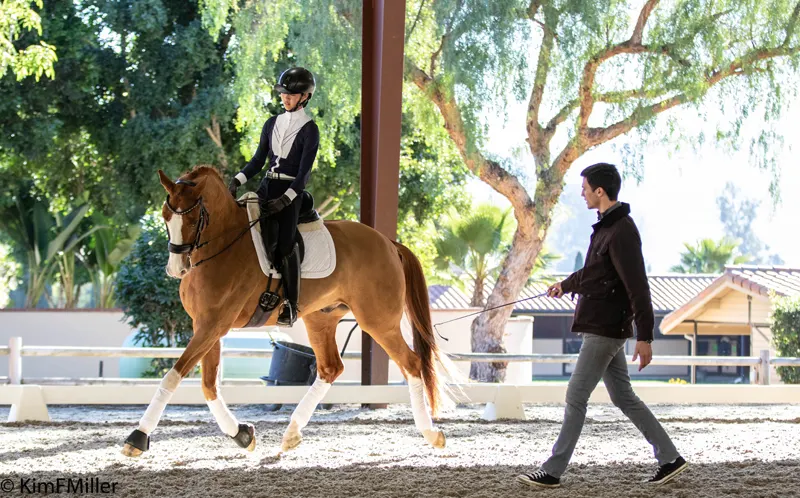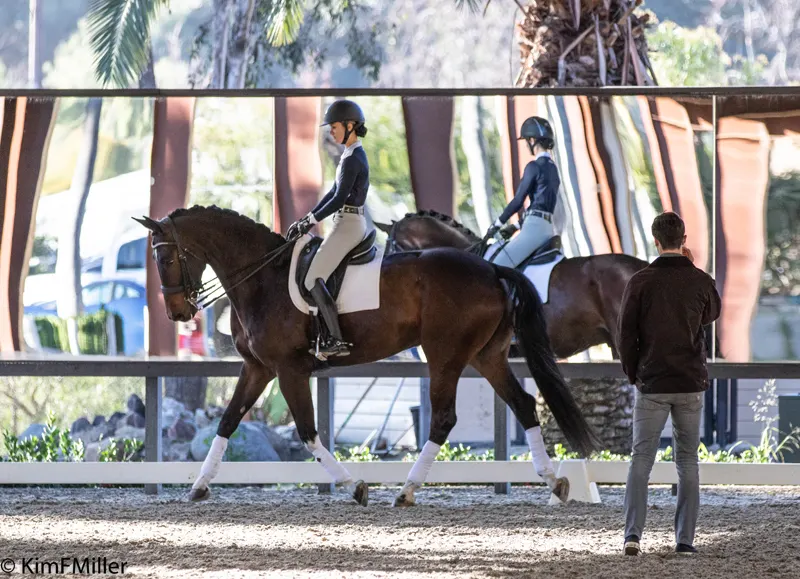At 22, Juan Matute Guimón isn’t much older than the young riders he coached during a Feb. 15-16 clinic in Southern California. His lifetime with horses and the tutelage of his three-time Olympian father, Juan Matute Sr., gave him wisdom beyond his years, and he shared it with wit, candor and passion.
Matute Jr.’s accomplishments include representing his native Spain in the 2018 FEI World Equestrian Games (North Carolina). He’s currently No. 9 in the Western European World Cup League, giving him a place in Las Vegas if the standings hold. That’s all while “very slowly” pursuing a college degree in Madrid.
“Not only is he a good example,” said 16-year-old Katherine Mathews, who rode two horses in the clinic in San Diego County at Peridot Equestrian, which is owned by her mother, Jessica Eaves Mathews. “It’s like he’s breaking the ice, saying this is possible.”
Like all the clinic participants, “Kate” has international aspirations. Like most of her fellow riders, she received Matute Jr.’s most common advice: Ride more assertively, more effectively and with more power. “It’s OK to look pretty, but don’t be afraid to show your warrior side, too!” was one of Kate’s takeaways.
Matute Jr. noted a marked difference when Kate warmed up her 7-year-old mare on Sunday. “Yesterday, you were too shy,” he said. “I want you to ride with more emotion and determination, which is not the same as over-riding.”
He added that Kate and the other riders should work hard every stride, even when their horses weren’t. During walking rest breaks, Matute Jr. said, “This is a break for your horse, not for you,” a theme he repeated throughout each session.
More Power
Kate first heard the call for more power while riding her Hanoverian stallion Soliere (Sandro Hit—Donatella, Donnerhall), one of two horses she brought to the clinic. When asked for a collected gait or half-pass, “Soli” sometimes opened his mouth in resistance, which Kate attributed to a lack of suppleness. “I’d always thought that if I added more or too much power, he’d be so strong I wouldn’t be able to do anything with him,” she said. “Instead, I found that adding more power made him so supple and flexible.”
Matute Jr. encouraged riders to push the envelope. “I’d rather see you get a 4 because your horse broke into the canter, than see the boring trot with no energy,” he said.
Using the terms “power” and “tempo” where others might have said “forward, just go!” helped Kate discern the fine line between driving a horse forward and onto the forehand or engaging the hindquarters for forward power while maintaining a round, balanced frame.
It was one of many juggling acts Matute Jr. asked of the riders. For example, even while working on relaxed, long and low walks and trots, he said, “Even though this is ‘friendly’ riding, the horse also needs to be very focused and ready for you to sit down and ask for a 10 trot.”
ADVERTISEMENT
In every scenario, power or “go” aids are leg and seat, into the contact of the hand, Matute Jr. emphasized. Even in collection and downward transitions, including to the halt, the hand is always last and lightest. The halt, he noted, is too often neglected in training and a frequent point-loser in tests. The movement is not a halt of energy, Matute Jr. clarified. It’s a halt of mobility. A square halt in which the horse is prepared to move lightly and quickly into the next movement is achieved “not by stopping the movement from the front: It’s from riding from behind into contact.”
Work Hard And Loosen Up
Matute Jr. urged the San Diego riders to both work extremely hard and to loosen up. Some strove to be “too pretty” in their position, versus being effective and decisive with their aids and intentions. Although most of Sunday was focused on exercises geared toward competition, he reminded riders not to seek perfection when training for it.
“There tends to be worry about ‘pretty’ and pressure to have everything perfect,” he said. That leads to tension that is absorbed by the horse.
“Breathe in and out,” he told one rider. “The horse is a reflection of its rider. He’ll do what they feel.”
Pulling on the reins is one of the biggest manifestations of rider tension, he noted, and a sure way to break the elegant elasticity sought in training.
Pursuing perfect also made it hard for many dressage riders to reward their horse when needed. “My father is always reminding me to give my horses a pat,” said Matute Jr. “It can be hard to keep perspective because we get so lost in feeling that we made a mistake. The horse doesn’t understand our obsession with perfection. When your horse tries to do what you want, give them a pat.”
He encouraged experimenting with moves above the horse and rider’s competitive level, as appropriate to the horse’s training and development. Sixteen-year-old Erin Nichols, for example, won’t be asked for tempi changes in the Junior Test she’ll contest in pursuit of a Region 7 North American Youth Championships berth. But there was no harm in playing with them a little while schooling, Matute Jr. said. “Take a risk. Have some fun. Providing your horse is ready for it, it’s good to try some upper-level exercises. You lose nothing, and it makes everything else easier.”
The three- and four-tempis Nichols and her 8-year-old Dutch Warmblood, Handsome Rob AR, executed improved when she embraced Matute Jr.’s advice to “feel the wind in your face.” She rode them with pace and propulsion across the diagonal.
After the session, Nichols said “always be moving and thinking forward” was her main takeaway from the weekend. Her relatively new horse has a lovely canter and walk, “but we knew early on that we need to improve his trot as we go up the levels, and it’s been great to get Juan’s insights.”
Nichols is also a jumper rider and has excelled in hunter/jumper equitation and dressage seat equitation, earning the reserve championship at the USEF Dressage Seat Medal Finals (Illinois) in the 14-18 division last year. So, she was especially attuned to Juan’s statement that “sitting pretty” isn’t enough.
ADVERTISEMENT
“I know I’ve got to work on effectiveness and that, even when your horse is a little worried, you can’t be afraid to really work with him in the ring,” she said.
Rhythm, Frame And Intensity
At every level of training, the rider should understand how to get control of each part of the horse’s body, especially the back and the role that its suppleness plays in the elasticity of the horse’s entire frame and topline. “It’s a play between rhythm, frame and intensity,” Matute Jr. said. “It’s important not to lose that feeling.”
Increasing the step and power of the inside hind leg was a task assigned for several horses, often achieved while riding a circle around Matute Jr. Holding a longe whip, he sometimes simply held it behind the horse. In other instances, it was light taps at the hindquarters and occasionally atop the croup to encourage the horse to drop the hindquarters and bring the leg further underneath itself.

Juan Matute Guimón used a longe whip to help clinic participant Miki Yang encourage Bailarino to bring his hind legs further underneath his body.
Similar exercises helped riders who needed to get quicker and more sustained responses from their leg aid. At the canter, Matute Jr. described the desired sensation as “the horse pushing into your seat with its hind legs,” a sensation that is the ideal precursor to cueing a light, clean, high scoring flying change.
Matute Jr. shared his struggle with the FEI Individual Junior test’s dreaded 20-meter half-circle stretch on a long rein, right in front of the judge. “I always hated that!” he said with a laugh. “Only the Germans do that well!”
In this and other stretching exercises, he coached an active hand that moves forward to encourage the horse to lower its head and neck into contact and to move freely in the shoulder, supported with a deep seat. Giving that extra rein was sometimes a matter of “having the confidence to take the risk of giving it,” Matute Jr. noted.
The young Spanish rider’s schedule does not allow him to teach clinics often, but he obviously enjoyed it. Each of Sunday’s sessions ended with Matute Jr. inviting the student to ask him training questions and an accounting of positive traits and progress over the weekend.
The unusual opportunity to ride with Matute Jr. came about through Peridot Equestrian-based trainer Verena Sonstenes-Mahin, who trains with Juan Matute Sr. and has known his son for years.
“He has been a delight to work with,” said Jessica Eaves Mathews, who plans to make the facility a hub for dressage education on the West Coast. In April, Carl Hester, will present a “Through The Levels” clinic, and the Chronicle will be onsite to report.
















